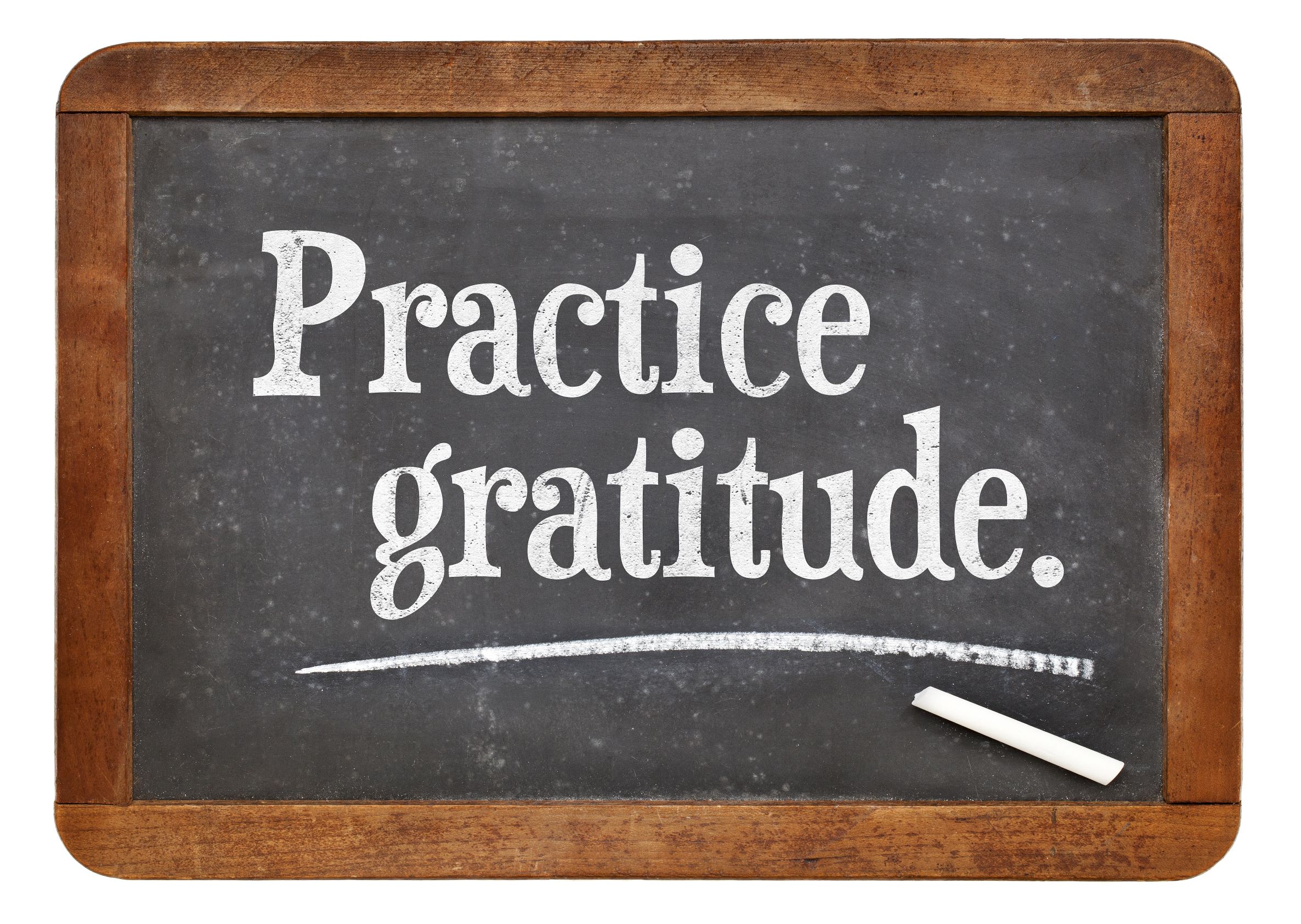
Raising money for your small nonprofit is stressful during the holidays, and practicing personal gratitude can pull you through.
There are year-end fundraisers and volunteer appreciation events to attend, donors to thank, holiday cards to get in the mail, and last-minute appeals to send out.
Your programs may also rev up during the holidays, providing meals and gifts, keeping people who are homeless warm, or preparing for an influx of post-holiday pets needing homes.
And almost everyone involved in your organization—volunteers, staff, and donors—is juggling all the obligations that come with the holidays: planning family meals, shopping for gifts, figuring out whose mother’s house to go to, helping out with church programs, and seeing relatives that you only see once a year—and that’s more than enough!
Whew!
According to the calendar, we’re supposed to start counting our blessings around Thanksgiving and work our way up to total and complete joy by New Year’s Eve.
But, honestly, this time of year seems harder, especially when fundraising goals are bearing down.
Forget a sense of peace and happiness. You’re just wondering if you can muddle through until the new year!
So, what’s the remedy for all the stress and anxiety we’re all dealing with? Believe it or not, it’s simple: personal gratitude.
How Personal Gratitude Helps
“When it comes to life, the critical thing is whether you take things for granted or with gratitude.” — G.K. Chesterton
Stress keeps us anxious about the future. Gratitude brings us into the moment and allows us to feel peace.
Studies show that people who practice personal gratitude have more positive emotions, less stress, fewer health issues, a greater sense of optimism, and higher satisfaction with their jobs and co-workers.
That sounds great, right?
So how do you go about creating a culture of personal gratitude for yourself and for your organization?
 It might seem impossible to achieve this time of year when you’re already in a sprint to the finish line, but taking a little time to practice personal gratitude will help you silence the noise surrounding your stress so you can enjoy the season.
It might seem impossible to achieve this time of year when you’re already in a sprint to the finish line, but taking a little time to practice personal gratitude will help you silence the noise surrounding your stress so you can enjoy the season.
As a nonprofit leader, you probably already have your organization on your heart and mind 24/7.
Your work is an extension of yourself, and fulfilling your organization’s mission is a personal calling.
Because of that, the first thing you need to do is establish your own personal gratitude practice.
Gratitude is a lens that you can use to see the world a little differently.
It means changing your focus to the things you do have rather than stressing about all the things you don’t have.
There are some simple things you can do to help change your focus and improve your mental health in the process.
When you experience these changes, your organization will benefit.
5 Ways to Practice Personal Gratitude
1. Gratitude journal. Choose a time every day to write in a gratitude journal. It can be at night just before you go to bed, or when you get up in the morning (after you have coffee, of course).
Just write down 3 things you’re grateful for.
If you feel mired in stress and anxiety, you might have a tough time with this exercise. That’s okay.
Do you have running water? Did you get enough to eat today? Do you have a warm, sweet puppy sitting in your lap?
Those are all things you can feel thankful for.
No matter how big or how small, don’t be afraid to add things to your journal. Also, don’t worry about putting the same thing twice.
If you come across a quote about gratitude that you like, add that to the journal.
When you’re feeling stressed or down, take out the journal and look at it.
This practice may feel a little forced at first.
Gratitude is a muscle that needs exercise.
You’ll find it gets easier the more you use it.
2. Gratitude and complaint boxes. Place two boxes on your desk, your kitchen table, or by your door – somewhere where you can’t overlook them.
Label one Complaints and one Gratitude.
Next time you’re stressed or have something you want to complain about, write your complaint on a piece of paper and put it in the complaint box.
Then write something that you’re grateful for and place it in the gratitude box.
Make yourself write a gratitude note, even if you don’t feel like it, so the complaint box never outweighs the gratitude box.
 3. Block off 5 minutes a day for gratitude mindfulness.
3. Block off 5 minutes a day for gratitude mindfulness.
Set a timer for 5 minutes.
Take deep breaths and let negative thoughts go, concentrating on something positive: your kids, grandkids, your spouse, your garden, chirping birds, the feeling of the sun on your arms – whatever makes you feel good.
Use this exercise daily to keep your head in the right place.
You can also use it when you’re feeling stressed before a big meeting, you just heard bad news, or after a clash with a Board member or donor.
If you don’t have 5 minutes, take 10 deep breaths, releasing negative thoughts with each exhale.
When you inhale, think about something you’re grateful for.
4. Replace negative thoughts with positive thoughts. Do you often find yourself thinking negative thoughts about yourself and others? I sure do.
Next time that happens, write down the negative thought.
Next to it, write a more positive thought that flips the situation.
For example, if you’re afraid to ask a major donor to write an even bigger check this year, write down your fear. Why are you afraid? Is it because you think you’ll come across as greedy? Are you afraid of making your donor mad?
Write down your feelings, especially the ones you have trouble articulating.
Then, remember that this donor loves your cause. Write down the positive things the donor has done over the years. Write down how this donation will allow that donor to become a hero.
If you have a staff member whose disorganization drives you nuts, write that down. Next, write down their best qualities and talents. Creative, passionate, outside-the-box thinker. We all have strengths and weaknesses.
Writing down a person’s strengths alongside their weaknesses doesn’t erase the problem you need to work with the employee to solve.
Being disorganized is a problem that affects the team and the nonprofit, but the exercise will help you move forward in a positive way.
Over time, this attitude will become second nature.
5. Stop playing the comparison game. Comparing ourselves and our nonprofits to others just makes us feel bad.
Focusing on someone else’s achievements and skills means we’re not concentrating on the unique talents and gifts that make us special.
It’s okay to appreciate and incorporate good ideas from others, but as Dr. Seuss said,
“Today you are You, that is truer than true. There is no one alive who is Youer than You.”
Your unique gifts and talents mean that your path will be different. Envy achieves nothing. Believe me, I know this one is hard.
Run your own race.
You should also extend this courtesy to staff, volunteers, and Board members.
Don’t compare your new Board president to the one you loved 5 years ago. Learn to appreciate people for the unique skills they bring to the table.
Establish a Culture of Personal Gratitude at Your Nonprofit
As you become more aware of the positive effects of personal gratitude in your own life, you’ll be more able to establish the same attitude with your staff, Board, and volunteers.
Remember that an organization-wide positive outlook starts with leadership. That’s you!
Start by modeling the behavior you want to see. Use these ideas to further instill a culture of personal gratitude.
The Bottom Line
You have a lot of responsibility when you’re running a nonprofit.
Sometimes you will feel stress and anxiety, particularly in the very season when you’re supposed to be joyful and merry.
But you don’t have to stay on the treadmill of worry, exhausting yourself about what could happen to your organization down the road.
You can choose the path of personal gratitude and ground yourself in the present.
Personal gratitude starts with you, and then works its way outwards toward your staff, your volunteers, your beneficiaries, and your donors.
A few small changes in perspective can lead to seeing the world – and the holidays – in a whole new light.

 Thank your staff and volunteers for a job well done. This may seem like a no-brainer, but think about it. In the rush of doing the million-and-one things that need to get done every day, how often do you simply thank people?
Thank your staff and volunteers for a job well done. This may seem like a no-brainer, but think about it. In the rush of doing the million-and-one things that need to get done every day, how often do you simply thank people? Remind everyone what your organization has overcome. From time to time, your nonprofit may go through a rough patch. After you come through it, take a few minutes at a staff meeting or send out an email to remind everyone of what you’ve achieved through the hard times. When you express gratitude for meeting challenges, it makes the future seem brighter and more doable.
Remind everyone what your organization has overcome. From time to time, your nonprofit may go through a rough patch. After you come through it, take a few minutes at a staff meeting or send out an email to remind everyone of what you’ve achieved through the hard times. When you express gratitude for meeting challenges, it makes the future seem brighter and more doable.





It really is so important to have an organizational culture of gratitude at a nonprofit. And people who feel valued are more likely to value others!
Absolutely! Gratitude should be part of the culture of EVERY nonprofit!
[…] sincere message of thanks, skip the jargon and use a real voice. For inspiration, try flexing your personal gratitude muscles and send thank you notes to some of your organization’s first time […]